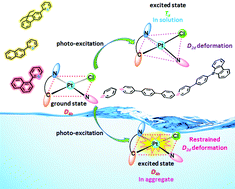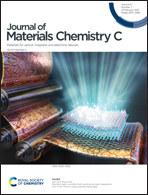Aggregation-induced phosphorescence emission (AIPE) behaviors in PtII(C^N)(N-donor ligand)Cl-type complexes through restrained D2d deformation of the coordinating skeleton and their optoelectronic properties†
Abstract
A series of four-coordinated PtII(C^N)(N-donor ligand)Cl-type complexes have been synthesized through combination between C^N-type and N-donor ligands with different sizes. Photophysical features, electrochemical behaviors and electroluminescent (EL) performances have been investigated in detail. Critically, the relationship between the size of organic ligands and aggregation-induced phosphorescence emission (AIPE) behaviors for these PtII(C^N)(N-donor ligand)Cl-type complexes has been characterized. With extending the dimensions of the C^N-type and/or N-donor ligands, the AIPE of these PtII(C^N)(N-donor ligand)Cl-type complexes is more likely to show up with lower H2O volumetric fractions (fw) in the THF solution of these complexes. These unique AIPE experimental results have clearly revealed a new AIE mechanism called restrained D2d deformation of the coordinating skeleton of these PtII(C^N)(N-donor ligand)Cl-type complexes from square-planar (D4h) in the ground states to the tetrahedron (Td) skeleton in the excited states. In addition, solution-processed organic light-emitting diodes (OLEDs) based on these AIPE emitters have been fabricated to characterize their EL potential. Impressive EL efficiencies with the maximum external quantum efficiency (ηext) of 25.2%, current efficiency (ηL) of 53.9 cd A−1 and power efficiency (ηP) of 43.5 lm W−1 can be achieved, indicating great potential of these PtII(C^N)(N-donor ligand)Cl-type AIPE emitters in the field of OLEDs. Importantly, this research has proposed a new AIE mechanism to promote the development of new phosphorescent AIPE complexes with great potential in the field of OLEDs.



 Please wait while we load your content...
Please wait while we load your content...